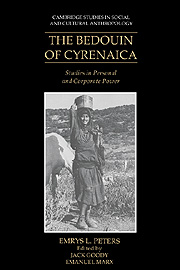Book contents
- Frontmatter
- Contents
- List of illustrations
- Foreword by Jack Goody
- Preface
- Introduction by Emanuel Marx
- 1 The Sanusi order and the Bedouin
- 2 The Bedouin way of life
- 3 The tied and the free
- 4 Aspects of the feud
- 5 Proliferation of segments
- 6 The power of shaikhs
- 7 Debt relationships
- 8 Family and marriage
- 9 Bridewealth
- 10 The status of women
- Notes
- Bibliography
- Index
- Cambridge Studies in Social and Cultural Anthropology
- Plate section
1 - The Sanusi order and the Bedouin
Published online by Cambridge University Press: 02 December 2009
- Frontmatter
- Contents
- List of illustrations
- Foreword by Jack Goody
- Preface
- Introduction by Emanuel Marx
- 1 The Sanusi order and the Bedouin
- 2 The Bedouin way of life
- 3 The tied and the free
- 4 Aspects of the feud
- 5 Proliferation of segments
- 6 The power of shaikhs
- 7 Debt relationships
- 8 Family and marriage
- 9 Bridewealth
- 10 The status of women
- Notes
- Bibliography
- Index
- Cambridge Studies in Social and Cultural Anthropology
- Plate section
Summary
‘One of the few genuinely historical books written by an anthropologist de carrière is my own book The Sanusi of Cyrenaica’ (Evans-Pritchard 1962: 184). The purpose here is to examine the way in which one of our foremost social anthropologists, whose initial training, at Oxford, was as historian, attempted to write the developmental history of the transformation of a religious fraternity into a political organisation. Throughout the book a consistent argument is pursued which, as I understand it, is woven around nine main issues. In this chapter, these will be summarised; then the theoretical premises on which the argument rests will be discussed critically, and an alternative view will be put forward.
First, when the founder of the Sanusi Order, Sayyid Muhammad ibn ʿAli as-Sanusi (hereafter referred to as the Grand Sanusi, a title often given him), went to reside on the plateau area of Cyrenaica, near the classical site of Cyrene, driven there by the ill winds of circumstance, he found there already existed a tradition of veneration for holy men. The Marabtin biʿl-Baraka (clients with divine blessing), who, until now, live in small groups among the tribes, had long lived in the country. The Grand Sanusi and his disciples were, like them, Sunni Muslims, of Arabic speech, grown accustomed to Bedouin ways during their extensive travels across the deserts of North Africa, and accredited with saintliness of sorts, by virtue of their descent from the Prophet (Evans-Pritchard 1944), their teachings and their habits.
- Type
- Chapter
- Information
- The Bedouin of CyrenaicaStudies in Personal and Corporate Power, pp. 10 - 28Publisher: Cambridge University PressPrint publication year: 1991

